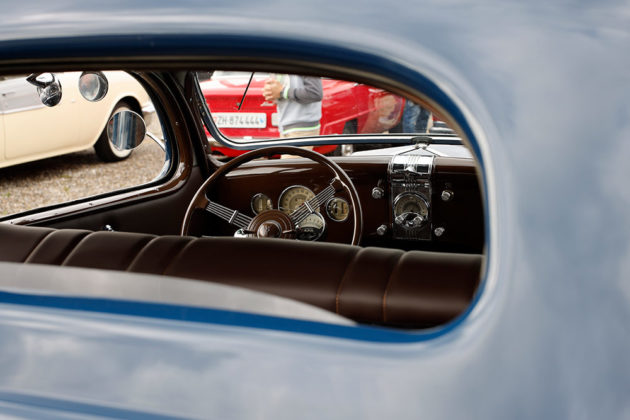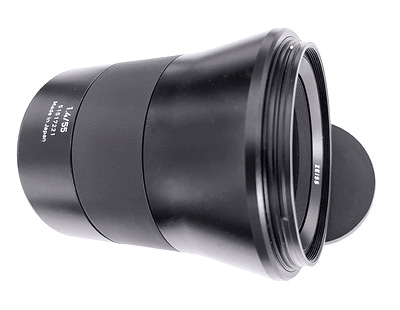Lens overview
The ZEISS Otus 55 mm f/1.4 APO‑Distagon T* is the original “no‑compromise” Otus, announced in October 2013 for Canon EF (ZE) and Nikon F (ZF.2). It’s a manual‑focus, apochromatic design with 12 elements in 10 groups, 77 mm filters, and a 0.5 m minimum focus distance. Angular field is ≈43.7° (diag). Weight is 1030 g (ZE) or 970 g (ZF.2). In practice, performance is prime‑of‑the‑decade territory at f/1.4 with exceptional correction of LoCA and field curvature. Apo‑Distagon set out to behave like a medium‑format standard lens on 35 mm sensors.
Manufacturing: The Otus 55 is built in Japan by Cosina to ZEISS specifications (the Otus line is part of ZE/ZF.2 SLR lenses manufactured by Cosina in Nagano Prefecture). Zeiss Otus lens family.
Pricing (then & now):
- Launch (Oct 2013): $3,999 / €2,940.
- Current new street (example): ~US $2,790 on promotion (B&H).
- Used market (typical): roughly US $1,8k–2,7k depending on mount/condition (KEH/MPB/eBay snapshots).
Build and ergonomics
All‑metal barrel, long focus throw (≈248°), hard infinity/MOD stops, and the familiar Otus rubberized focusing ring. The ZE (EF) version is electronically controlled for aperture by the camera; the ZF.2 (F) version includes a mechanical aperture ring with CPU contacts for metering. It’s big and heavy for a “normal” lens (Ø92 mm), yet beautifully balanced on pro bodies or with a grip; the 77 mm filter size keeps accessories practical.
Optical performance
- Sharpness: Among the best measured—superb center and high edge uniformity even near f/1.4, with further refinement by f/2–2.8. Independent tests (DXOMARK) placed it at the top of their charts at launch.
- Color & contrast: Apochromatic correction with low axial/lateral CA and high micro‑contrast; neutral color that grades cleanly.
- Bokeh & rendering: Smooth transitions and high subject “pop”; specular highlight shape stays roundish off‑axis for a fast normal, with minimal onion‑ringing thanks to excellent polishing and coatings.
- Flare & ghosting: T* coatings and internal baffling keep artifacts very low; a hood is still recommended around strong sources.
- Distortion & vignetting: Very low distortion; mild vignetting wide open that eases by f/2.8.
Digital adaptation
- Mirrorless (RF / Z / E / L):
- ZE (EF) copies adapt with an active EF adapter (camera controls aperture; EXIF transmits).
- There is no native RF mount for this lens, but it can be adapted to RF cameras with the standard EF-to-RF adapter.
- ZF.2 (F) copies adapt with a simple F‑to‑mirrorless ring; aperture is set on the lens ring.
- Both versions retain infinity focus; IBIS bodies benefit—set 55 mm manually.
- DSLR use: Native EF or F operation as intended; focus confirmation works via lens CPU, but AF is manual only.
Why Zeiss keeps Otus MF-only:
- Optical-first brief: Otus was created as a “no-compromise” reference lens. Keeping it MF avoids AF module size/weight constraints and lets Zeiss use a very long, precise throw (~248°) for pinpoint manual focusing.
- Consistency across mounts: The original Otus (EF/ZF.2) and the newer Otus ML (E/RF/Z) are positioned identically—manual focus for deliberate shooting. Even Zeiss’s own announcements for the ML lenses highlight MF as a feature, not a limitation.
- Business/licensing history: Zeiss has offered AF in other lines where it made sense (e.g., Batis for Sony E), but Otus has always targeted the “precision MF” niche rather than speed/AF use-cases. Industry commentary and reviews have long noted “no AF” as a conscious choice, not an omission.
Historical and collector context
Otus, as a project, was a statement: primes that stay optically honest at full aperture on high‑resolution sensors. The opening statement was this: Otus 55 mm f/1.4 (Apo‑Distagon)—a retrofocus standard lens chosen to control better oblique rays, field curvature, and axial color than classic double‑Gauss designs. Its wide‑open files showed finished micro‑contrast and edge integrity, proving a fast normal didn’t have to trade away discipline. The Otus 85/1.4 (Apo‑Planar) followed as the portrait counterpart, extending the approach to short‑tele rendering. Set against beloved classics like the Canon FD 85 mm f/1.2 L, the difference in philosophy is clear: the FD is romantic and fast, with period LoCA and a softer edge discipline; the Otus lenses aim for color fidelity, consistent planes, and neutrality. In the 2025 Otus ML relaunch, ZEISS carried that ethos to native mirrorless with updated mechanics, smaller filters on some focal lengths, and modern convenience—leaving the original ZE/ZF.2 55 is a well‑regarded reference piece that still holds value.
Impressions
In the field, the Otus behaves like a medium‑format‑grade normal: precise, repeatable focusing and files with crisp micro‑contrast that tolerate heavy post-work. It rewards careful technique (magnified MF, peaking), and on IBIS bodies, you can comfortably hand‑hold in lower light than with DSLRs. The only real trade‑offs are mass/size and manual focus, which many owners consider part of the appeal.
Sample Photos
Verdict — Pros and Cons
Pros
- Class‑leading sharpness and correction from wide open; apochromatic design
- Superb build and 248° focus throw for precise MF; 77 mm filters
- Adaptable to all major mirrorless mounts with complete control (ZE via active EF; ZF.2 via aperture ring)
- Holds value; the used market is active
Cons
- Large and heavy for a standard prime (up to 1030 g
- Manual focus only; demands careful technique.
- Premium price, even used; alternatives can come close optically for less









